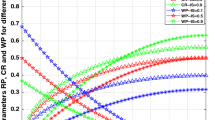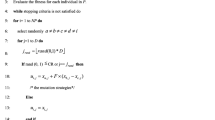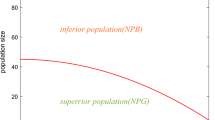Abstract
A new variant of Differential Evolution (DE), called ADE-Grid, is presented in this paper which adapts the mutation strategy, crossover rate (CR) and scale factor (F) during the run. In ADE-Grid, learning automata (LA), which are powerful decision making machines, are used to determine the proper value of the parameters CR and F, and the suitable strategy for the construction of a mutant vector for each individual, adaptively. The proposed automata based DE is able to maintain the diversity among the individuals and encourage them to move toward several promising areas of the search space as well as the best found position. Numerical experiments are conducted on a set of twenty four well-known benchmark functions and one real-world engineering problem. The performance comparison between ADE-Grid and other state-of-the-art DE variants indicates that ADE-Grid is a viable approach for optimization. The results also show that the proposed ADE-Grid improves the performance of DE in terms of both convergence speed and quality of final solution.







Similar content being viewed by others
References
Fogel DB (1997) The advantages of evolutionary computation. In: Proceedings of the international conference on bio-computing and emergent computation. World Scientific, pp 1–11
Storn R, Price K (1995) Differential Evolution—a simple and efficient adaptive scheme for global optimization over continuous spaces. International Computer Science Institute, Berkeley. Tech. Rep. TR-95–012
Storn R, Price K (1997) Differential evolution—a simple and efficient heuristic for global optimization over continuous spaces. J Glob Optim 11:341–359. doi:10.1023/A:1008202821328
Mallipeddi R, Suganthan PN, Pan QK, Tasgetiren MF (2011) Differential evolution algorithm with ensemble of parameters and mutation strategies. Appl Soft Comput 11:1679–1696. doi:10.1016/j.asoc.2010.04.024
Wang Y, Cai Z, Zhang Q (2011) Differential evolution with composite trial vector generation strategies and control parameters. IEEE Trans Evol Comput 15:55–66. doi:10.1109/TEVC.2010.2087271
Brest J, Zamuda A, Boskovic B et al (2009) Dynamic optimization using self-adaptive differential evolution. In: IEEE congress on evolutionary computation, pp 415–422
Noroozi V, Hashemi AB, Meybodi MR (2012) Alpinist CellularDE: a cellular based optimization algorithm for dynamic environments. In: Proceedings of the fourteenth international conference on genetic and evolutionary computation conference companion. ACM, New York, pp 1519–1520
Kordestani JK, Rezvanian A, Meybodi M (2014) CDEPSO: a bi-population hybrid approach for dynamic optimization problems. Appl Intell 40:682–694. doi:10.1007/s10489-013-0483-z
Xue F, Sanderson AC, Graves RJ (2003) Pareto-based multi-objective differential evolution. In: The 2003 congress on evolutionary computation, pp 862–869
Santana-Quintero LV, Coello CAC (2005) An algorithm based on differential evolution for multi-objective problems. Int J Comput Intell Res 1:151–169
Huang VL, Qin AK, Suganthan PN, Tasgetiren MF (2007) Multi-objective optimization based on self-adaptive differential evolution algorithm. In: IEEE congress on evolutionary computation, pp 3601–3608
Gämperle R, Müller SD, Koumoutsakos P (2002) A parameter study for differential evolution. In: Grmela A, Mastorakis NE (eds) Advances in intelligent systems, fuzzy systems, evolutionary computation. WSEAS Press, Interlaken, pp 293–298
Qin AK, Huang VL, Suganthan PN (2009) Differential evolution algorithm with strategy adaptation for global numerical optimization. IEEE Trans Evol Comput 13:398–417. doi:10.1109/TEVC.2008.927706
Das S, Suganthan PN (2011) Differential evolution: a survey of the state-of-the-art. IEEE Trans Evol Comput 15:4–31. doi:10.1109/TEVC.2010.2059031
Ali M, Pant M, Abraham A (2013) Unconventional initialization methods for differential evolution. Appl Math Comput 219:4474–4494. doi:10.1016/j.amc.2012.10.053
Rahnamayan S, Tizhoosh HR, Salama MMA (2007) A novel population initialization method for accelerating evolutionary algorithms. Comput Math Appl 53:1605–1614. doi:10.1016/j.camwa.2006.07.013
Rahnamayan S, Tizhoosh HR, Salama MM (2008) Opposition-based differential evolution. IEEE Trans Evol Comput 12:64–79. doi:10.1109/TEVC.2007.894200
Das S, Konar A, Chakraborty UK (2005) Two improved differential evolution schemes for faster global search. In: Proceedings of the 2005 conference on genetic and evolutionary computation. ACM, Washington DC, pp 991–998
Brest J, Greiner S, Boskovic B et al (2006) Self-adapting control parameters in differential evolution: a comparative study on numerical benchmark problems. IEEE Trans Evol Comput 10:646–657. doi:10.1109/TEVC.2006.872133
Brest J, Sepesy Mauèec M (2008) Population size reduction for the differential evolution algorithm. Appl Intell 29:228–247. doi:10.1007/s10489-007-0091-x
Liu J, Lampinen J (2005) A fuzzy adaptive differential evolution algorithm. Soft Comput 9:448–462. doi:10.1007/s00500-004-0363-x
Zhang J, Sanderson AC (2009) JADE: adaptive differential evolution with optional external archive. IEEE Trans Evol Comput 13:945–958. doi:10.1109/TEVC.2009.2014613
Gong W, Fialho Á, Cai Z (2010) Adaptive strategy selection in differential evolution. In: Proceedings of the 12th annual conference on genetic and evolutionary computation. ACM, Portland, pp 409–416
Sun J, Zhang Q, Tsang EPK (2005) DE/EDA: a new evolutionary algorithm for global optimization. Inf Sci 169:249–262. doi:10.1016/j.ins.2004.06.009
Zhang W-J, Xie X-F (2003) DEPSO: hybrid particle swarm with differential evolution operator. In: IEEE international conference on systems, man and cybernetics, pp 3816–3821
Kennedy J, Eberhart R (1995) Particle swarm optimization. In: IEEE international conference on neural networks, pp 1942–1948
Halder U, Das S, Maity D (2013) A cluster-based differential evolution algorithm with external archive for optimization in dynamic environments. IEEE Trans Cybern 43:881–897. doi:10.1109/TSMCB.2012.2217491
Storn R, Price KV, Lampinen J (2005) Differential evolution-a practical approach to global optimization. Springer, Berlin
Price KV (1999) An introduction to differential evolution. In: Corne D, Dorigo M, Glover F et al (eds) New ideas in optimization. McGraw-Hill Ltd, London, pp 79–108
Wang Y, Cai Z, Zhang Q (2012) Enhancing the search ability of differential evolution through orthogonal crossover. Inf Sci 185:153–177. doi:10.1016/j.ins.2011.09.001
Das S, Konar A, Chakraborty UK (2007) Annealed differential evolution. In: IEEE congress on evolutionary computation, pp 1926–1933
Kennedy J (1999) Small worlds and mega-minds: effects of neighborhood topology on particle swarm performance. In: Proceedings of the 1999 congress on evolutionary computation, pp 1931–1938
Kennedy J, Mendes R (2002) Population structure and particle swarm performance. In: Proceedings of congress on evolutionary computation, pp 1671–1676
Kennedy J, Mendes R (2006) Neighborhood topologies in fully informed and best-of-neighborhood particle swarms. IEEE Trans Syst Man Cybern Part C Appl Rev 36:515–519. doi:10.1109/TSMCC.2006.875410
Mendes R, Kennedy J, Neves J (2003) Watch thy neighbor or how the swarm can learn from its environment, pp 88–94
Omran MH, Engelbrecht A, Salman A (2006) Using the ring neighborhood topology with self-adaptive differential evolution. In: Jiao L, Wang L, Gao X et al (eds) Advances in natural computation. Springer, Berlin Heidelberg, pp 976–979
Das S, Abraham A, Chakraborty UK, Konar A (2009) Differential evolution using a neighborhood-based mutation operator. IEEE Trans Evol Comput 13:526–553. doi:10.1109/TEVC.2008.2009457
Han M-F, Liao S-H, Chang J-Y, Lin C-T (2013) Dynamic group-based differential evolution using a self-adaptive strategy for global optimization problems. Appl Intell 39:41–56. doi:10.1007/s10489-012-0393-5
Narendra KS, Thathachar MA (1974) Learning automata-a survey. IEEE Trans Syst Man Cybern:323–334. doi:10.1109/TSMC.1974.5408453
Thathachar MA, Sastry PS (2002) Varieties of learning automata: an overview. IEEE Trans Syst Man Cybern Part B Cybern 32:711–722. doi:10.1109/TSMCB.2002.1049606
Rezvanian A, Meybodi M (2010) LACAIS: learning automata based cooperative artificial immune system for function optimization. In: Ranka S, Banerjee A, Biswas K et al (eds) Contemporary computing. Springer, Berlin Heidelberg, pp 64–75
Hashemi AB, Meybodi MR (2011) A note on the learning automata based algorithms for adaptive parameter selection in PSO. Appl Soft Comput 11:689–705. doi:10.1016/j.asoc.2009.12.030
Moghiss V, Meybodi MR, Esnaashari M (2010) An intelligent protocol to channel assignment in wireless sensor networks: learning automata approach. In: International conference on information networking and automation, pp V1-338–V1-343
Esnaashari M, Meybodi MR (2011) A cellular learning automata-based deployment strategy for mobile wireless sensor networks. J Parallel Distrib Comput 71:988–1001. doi:10.1016/j.jpdc.2010.10.015
Akbari Torkestani J, Meybodi MR (2011) A cellular learning automata-based algorithm for solving the vertex coloring problem. Expert Syst Appl 38:9237–9247. doi:10.1016/j.eswa.2011.01.098
Barzegar S, Davoudpour M, Meybodi MR et al (2011) Formalized learning automata with adaptive fuzzy coloured Petri net; an application specific to managing traffic signals. Sci Iran 18:554–565. doi:10.1016/j.scient.2011.04.007
Akbari Torkestani J (2012) An adaptive learning automata-based ranking function discovery algorithm. J Intell Inf Syst 39:441–459. doi:10.1007/s10844-012-0197-4
Pant M, Thangaraj R, Singh VP (2009) A new differential evolution algorithm for solving global optimization problems. In: International conference on advanced computer control, pp 388–392
Wolpert DH, Macready WG (1997) No free lunch theorems for optimization. IEEE Trans Evol Comput 1:67–82
Suganthan PN, Hansen N, Liang JJ et al (2005) Problem definitions and evaluation criteria for the CEC 2005 special session on real-parameter optimization. Nanyang Technol. Univ., Singapore, IIT Kanpur, Kanpur, India, #2005005
Das S, Suganthan PN (2010) Problem definitions and evaluation criteria for CEC 2011 competition on testing evolutionary algorithms on real world optimization problems. Jadavpur University, Nanyang Technological University, Kolkata
Singh HK, Ray T (2011) Performance of a hybrid EA-DE-memetic algorithm on CEC 2011 real world optimization problems. In: IEEE congress on evolutionary computation, pp 1322–1326
Bandaru S, Tulshyan R, Deb K (2011) Modified SBX and adaptive mutation for real world single objective optimization. In: IEEE congress on evolutionary computation, pp 1335–1342
Elsayed SM, Sarker RA, Essam DL (2011) Differential evolution with multiple strategies for solving CEC2011 real-world numerical optimization problems. In: IEEE congress on evolutionary computation, pp 1041–1048
Reynoso-Meza G, Sanchis J, Blasco X, Herrero JM (2011) Hybrid DE algorithm with adaptive crossover operator for solving real-world numerical optimization problems. In: IEEE congress on evolutionary computation, pp 1551–1556
Acknowledgments
The authors would like to thank A. Rezvanian for his excellent insights, constructive comments and helpful suggestions on the initial version of the manuscript.
Author information
Authors and Affiliations
Corresponding author
Rights and permissions
About this article
Cite this article
Kordestani, J.K., Ahmadi, A. & Meybodi, M.R. An improved Differential Evolution algorithm using learning automata and population topologies. Appl Intell 41, 1150–1169 (2014). https://doi.org/10.1007/s10489-014-0585-2
Published:
Issue Date:
DOI: https://doi.org/10.1007/s10489-014-0585-2




